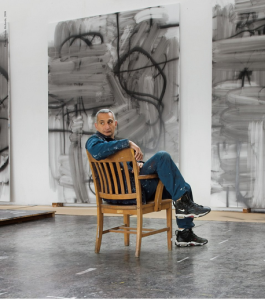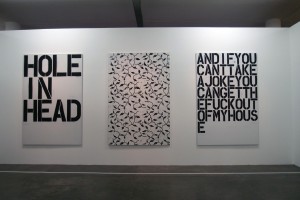THE PERENNIAL AMBIGUITY OF CHRISTOPHER WOOL
I like Christopher Wool’s artwork. Wool became famous for his paintings of strong, provocative phrases in black letters, primarily ALL CAPS. Wool’s works are of an abstract nature, sometimes intricate in presenting an idea, other times arcanely elusive. In October’s Vogue Dodie Kazanjian scored a rare interview with the media-reclusive artist. The format and presentation of the arguments the writer provides to the text more closely resembles that of an essay, but many intriguing themes come up.
By introducing Willem de Kooning’s approach to artistic work–who worked “out of doubt”–as a starting point, the writer reveals the artistic intentions of Wool to be consistent in their omnipresent questioning and doubting. They are works defined by what Kazanjian calls a “perennial ambiguity.” This ambiguity may also be viewed as the proclamation of the honest confusion of an artist. Thus, the refusal of adopting an authoritative style should not be considered the result of limited intellectual rigor, but rather should be respected for its humility.
Discussing his artistic aspirations and how he managed to become a significant part of the modern art world, Wool asserts that his path was somewhat coincidental. “It just kind of happened,” he states. A key to his success was possibly that his early years in New York coincided with a legendary era of NY nightlife and culture: CBGB and Max’s Kansas City. The intersection of nightlife and the art-reality that was being created was evident in the 1980s, and shaped the public’s perception of artists’ role.
Upon revisiting his old work, the artist himself confesses: “They were offensive, funny, and indelible–you had to pay attention.” Consequently, it is not surprising that the critical response to his work varied. Some thought it populist in its negativity, while others observed in it a radical stance: a cacophonous harmony, or a refreshing pathos. What is predictable in his work is Wool’s lack of “conclusiveness” or the absence of artistic closure.
“I firmly believe it’s not the medium that’s important, it’s what you do with it,” the artist clarifies.
THIS SEPTEMBER ISSUE: TWELVE REASONS TO CHOOSE HARPER’S
THE BRIEF HISTORY OF HARPER’S CLUB
Six days ago I received an email with the subject: “HARPER’S MAGAZINE RENEWAL.” The line of argumentation the email included was constructed by the magazine’s “Circulation Director.” I never read it, because I believe everything it said: I didn’t need to be persuaded in regards to the absolute necessity of my continued subscription. [1]
The motive that initially made me subscribe to Harper’s was my desire to intellectually engage on a more personal level with a friend from college, Dan. We both agreed that the depth of our homosocial rapports was not adequately profound, and because we enjoyed discussing with one another we eventually came up with the idea of what we jocularly referred to as “Harper’s Club.” [2] Dan’s academic interests were very different than mine, but we both enjoyed challenging various points of view in our pursuit of forming an informed opinion.
The planning of The Club’s meetings became impossible and our friendship never deepened. Regardless of this failure I could not be happier for the epiphenomenal ramifications of our failed initiative. By encouraging me to think about familiar subjects in different ways, “Harper’s Club” regularly challenged me as a thinker. This held true even when I was the solitary member of the Club, and continues to be valid to this day. Every time a new issue arrives in my mailbox I expect to encounter articles that serve this mission. My expectations are pleasantly surpassed consistently.
THOUGHTS ON ADS (ATTN: MIGHT BE FEELINGS!)



